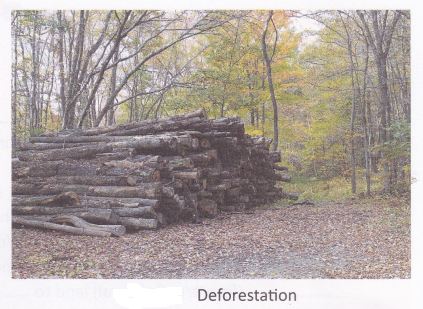Reasons for Loss of Biodiversity
Several species of plants and animals have become extinct in the last two centuries and there are many that face the threat of extinction. As life on Earth relies on the interactions and interdependencies among different plants and animals, biodiversity is essential for our own survival. Loss of biodiversity (because of extinction) is, therefore, one of the leading environmental problems today. Some of the major causes for loss of biodiversity are given below.
Destruction of forests: The loss or continual degradation of forest habitat due to natural or human- related causes is called deforestation. Following are the main reasons for deforestation.
- Requirement of wood is one of the main reasons trees are felled for. Wood is used as a fuel, for making furniture, in construction, and for making paper, boats, ships, artworks, and rayon. It is also processed to make plywood (used for making furniture) and hardboard (used in construction, and for making furniture).
- Overgrazing by cattle is also a key factor that contributes to deforestation.
- Rapid urbanization and increase in human population have led to conversion of forests to agricultural land. Forests have also been cleared for construction of roads, railway tracks, and dams.

Destruction of forests has the following adverse effects.
- Roots of trees help in binding the soil particles together. When trees are destroyed, soil is left loose and becomes prone to being eroded (i.e., being carried away) by wind and moving water. Loss of topsoil, which is rich in humus and nutrients, due to erosion reduces the fertility of soil. Over time, the fertile soil gets converted into a desert. This is called desertification.
- Forests are the natural habitat of many species of animals and birds. Cutting down trees destroys the homes of these species, which poses a threat to their survival.
- As trees take in carbon dioxide and give out oxygen during photosynthesis, their destruction disturbs the balance of these gases in the atmosphere. Increase in the concentration of carbon dioxide in the atmosphere may lead to an increase in global temperature.
- Trees draw ground water using their roots and release water vapour into the atmosphere through a process called transpiration. If a large number of trees are destroyed, overall transpiration .rate will be greatly reduced. This can make the atmosphere drier and lead to reduced rainfall.
- Trees help to absorb the rainwater that falls on the ground. If they are destroyed, this excess water could cause floods.
- Loss of trees may lead to reduction in the binding capacity of soil particles during rainy season. This may, in turn, lead to landslides in mountainous regions.
Pollution: Pollution of air, water, and land adversely affects many plants and animals.
Climatic changes: Natural and human activities have led to global climatic changes. Species that are not able to adjust to the changing climate become extinct.
Killing of animals: Many animals are killed for their meat, skin, and other body parts.
Natural disasters: Earthquakes, floods, droughts, cyclones, tsunamis, and hurricanes also contribute to the reduction of plant and animal species in many areas.
